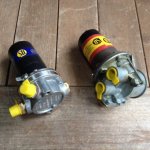Although I usually appreciate and agree with Bob, Iquestion whether he is correct in stating the superiority of the electronicpump over a points-triggered unit. In the past, the SU Electronic fuelpump was plagued with burnouts that left the user calling for a flatbed. On the other hand, I have also experienced points failure that has also left meon the side of the road. However, with the points, I was able to cleanand adjust the points and be on my way with the original pump and no flatbed. Better yet, by adding a TSV diode, the lifeof the points would be extended indefinitely without any maintenance. I personally like and have come to favor thepoints-triggered pump with TSV over the Electronic SU because of its long lifeand probability of being resurrected at the side of the road if it does fail…somethingthe Electronic unit can’t do.
Ray (64BJ8P1)
No issue, Ray. I've put almost 130K miles on my BJ8 in the 32 years I've owned it, much of it driving through some of the most remote areas in the US and Canada so having reliable kit is important to me. Fuel pumps have been the major bugaboo over the years; I've tried points with capacitor, points with diode--SU and home-made--Dave DuBois' points-switched power transistor mod, TSV diode-equipped, SU electronic kit, SU factory-installed electronic, and Dave's LED-triggered. Yes, the early SU electronic pumps--esp. the kits--were problematic. I believe SU has improved their design; I recall there are visible differences between the older and newer versions (I own both).
The issues with points-triggered is that the points will eventually erode (yes, the TSV-damped units are probably the best solution). Also, the points are--or should be--tungsten plated, tungsten will oxidize just sitting in the car or on the bench, and points pumps can be DOA if they've sat on the shelf too long. I'm not sure if it's because of the tendency to erode or oxidize, but the points sets are designed to 'sweep' the points so as to wipe corrosion and/or erosion off the points while running. Norman Nock once said filing and cleaning points was part of 'routine service' every 15K miles or so. I bought some point sets from Moss and the points surfaces were too shiny to be tungsten; they looked like they were silver and started eroding after just a few miles. I doubt SU Burlen would sell such junk; these appeared to be Chinese crap. Dave DuBois told me he had encountered same.
I lose track of what I've got now, but IIRC all the BJ8 pumps--I have five 'working' ones, I think--have been gone through by Dave. One of his modded pumps failed on me; Dave thinks it got water inside--we did drive through a couple deluges--which caused one of the IC traces to fry, so that's one potential downside of the electronics (note the pump caps should have an air check valve to allow points-generated ozone out and keep water out; make sure your pump has it--I don't think it comes with the pumps). And yes, I've spent hours in motel rooms dis/assembling pumps and filing points. Also, the procedure in the shop manual for adjusting tension on the diaphragm may not be correct; I THINK Dave told me they should be one 'hole' looser in case the electromagnet in the solenoid is on the weak side. I now carry two spare pumps, but the one I have in there has been solid for 15K miles or so; don't know what it is--I lose track. I can change out a pump in 20min on the side of the road blindfolded (but I'd rather not). For our BN2/100M I have both an SU electronic and a points pump; I think the points pump is in there now and it's been solid for the few hundred miles I've put on that car. If you carry a spare pre-install the studs. You'll save 5min.
Note electric fuel pumps can also be problematic in modern fuel-injected cars, and you have to drop the tank to replace them. And, we just put another mechanical pump in Dad's '55 T-Bird, and he has 3 or 4 old ones sitting on the shelf.
No question--the points pumps sound 'better.'

 Hi Guest!
Hi Guest!

 smilie in place of the real @
smilie in place of the real @
 Pretty Please - add it to our Events forum(s) and add to the calendar! >>
Pretty Please - add it to our Events forum(s) and add to the calendar! >> 

 :smile-new:
:smile-new:
